Discover the Azores: Best Tours, Trails, Volcanoes & Hidden Wonders
November 20, 2025
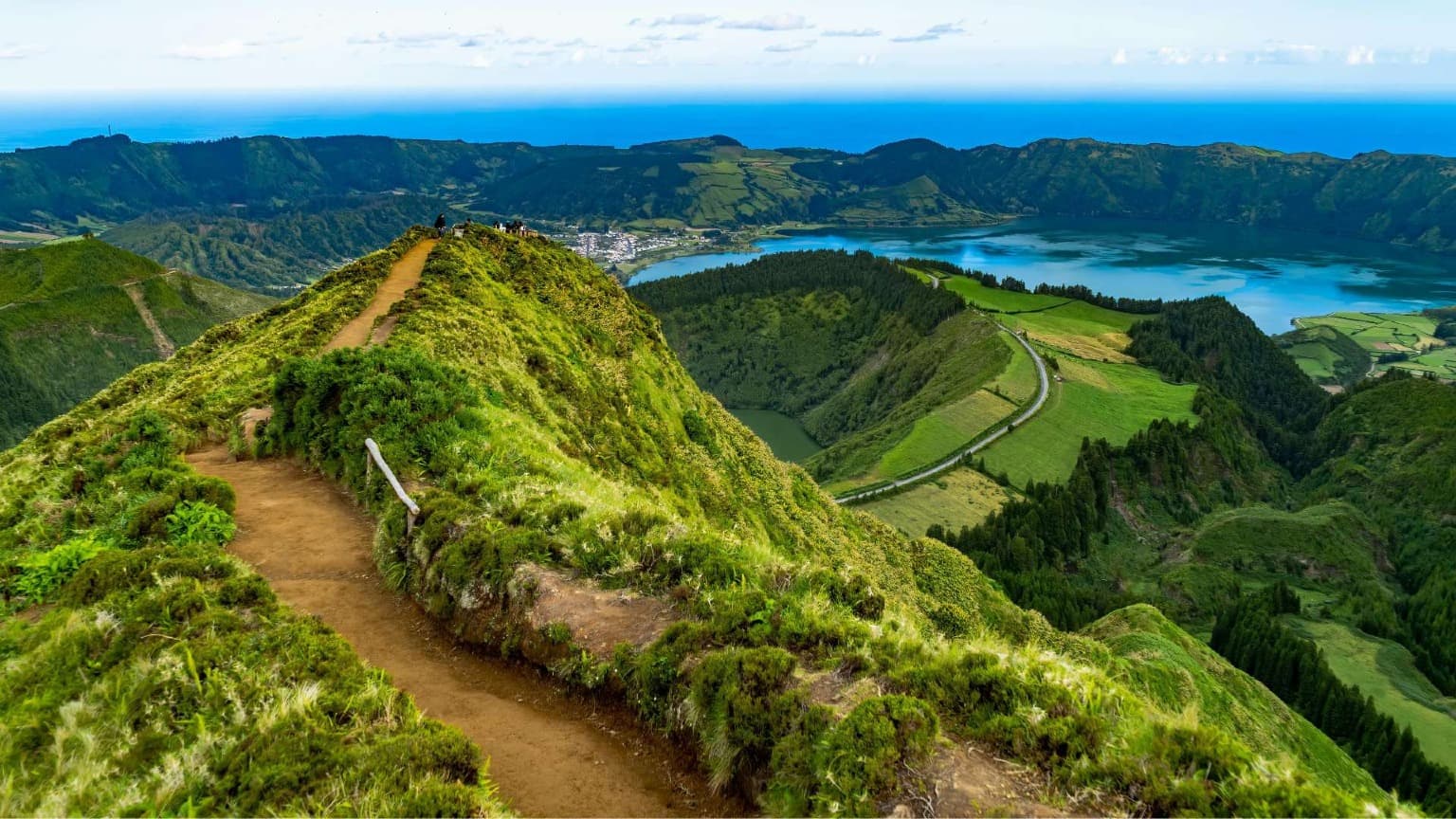
The ridge trail above Sete Cidades, offering some of São Miguel’s most iconic crater views.
Azores: Nature’s Sanctuary in the Atlantic
Deep in the North Atlantic, the Azores archipelago rises from the ocean as one of Europe’s last truly wild destinations — nine volcanic islands shaped by dramatic landscapes, crater lakes, thermal springs, waterfalls, and lush subtropical forests. Still untouched by mass tourism and protected as a UNESCO Global Geopark, the Azores offer a rare combination of adventure, tranquility, cultural authenticity, and sustainability.
Each island has its own identity: São Miguel with its twin-lake craters and thermal valleys; Terceira with volcanic caves and colorful heritage; Pico with Portugal’s highest mountain and UNESCO-designated vineyards; Faial with its marina culture and lunar landscapes; Flores and Corvo with some of the most pristine scenery in Europe; and Santa Maria, the island of golden beaches and warm microclimates.
For hikers, divers, food lovers, photographers, wellness travelers, or anyone who wants to reconnect with nature, the Azores deliver unforgettable experiences:
• Whale watching and marine wildlife tours
• Volcano trekking and crater hikes
• Thermal baths in Furnas, Ferraria and Carapacho
• Wine tasting in Pico’s UNESCO vineyards
• Waterfalls, canyoning and jungle-like trails
• Island-hopping between the central and western groups
If you’re planning your stay, Cooltour Oporto has curated a dedicated guide:
👉 The Best Sustainable Stays in the Azores Islands — handpicked eco-friendly hotels, farm stays, and nature-immersive accommodations across São Miguel, Faial, Pico and Terceira.
Planning to explore further? Check out our complete guides to the Douro Valley, Lisbon, Algarve, Central Portugal and more in our Portugal travel guides.
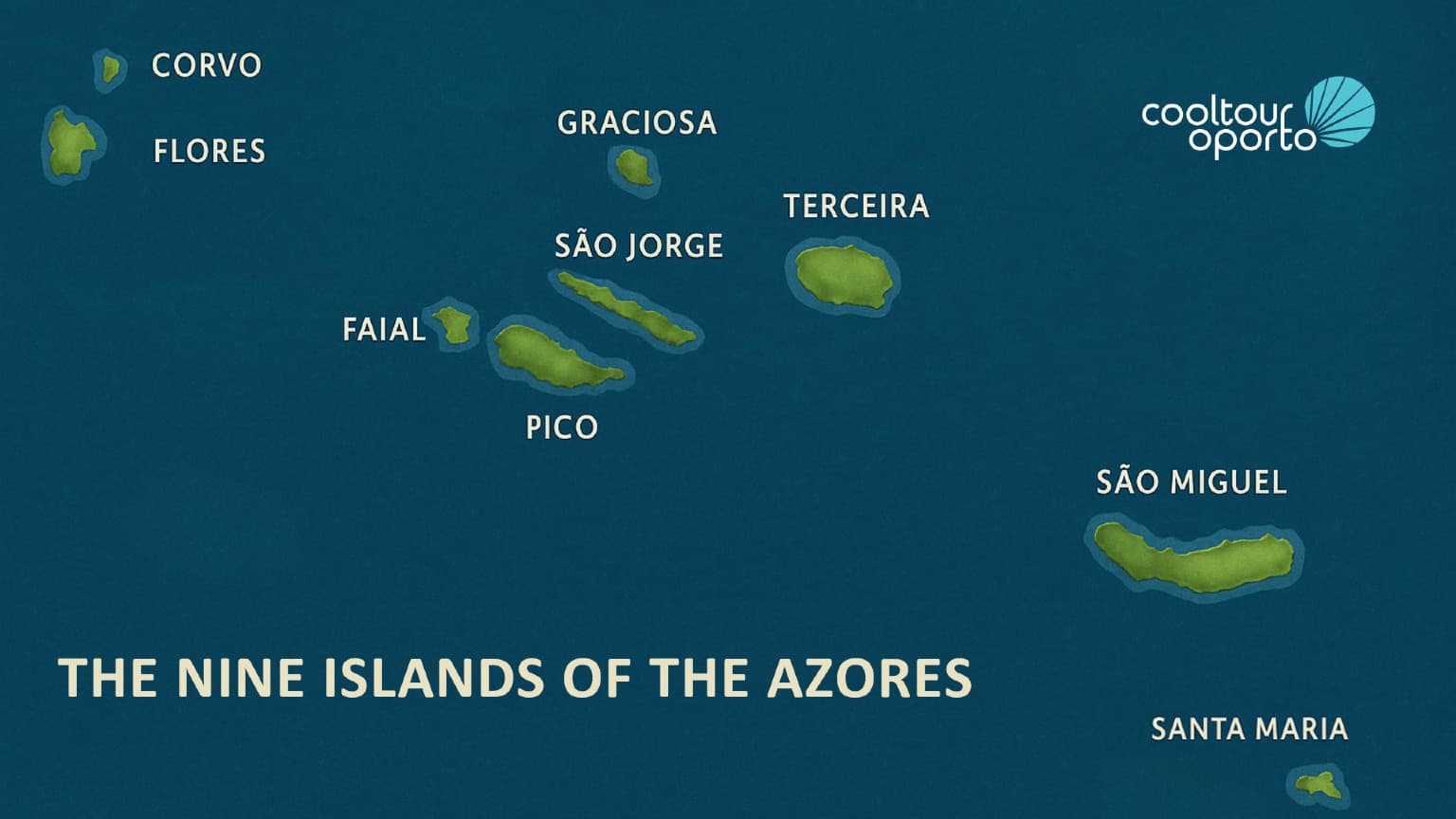
The nine islands of the Azores — from São Miguel to Corvo, each one with a distinct identity.
What to See and Do in the Azores
São Miguel – The Green Island
The largest and most accessible of the Azores, São Miguel is a tapestry of crater lakes, volcanic landscapes, tea plantations, and dramatic ocean cliffs — a perfect introduction to the archipelago’s natural wonders.
• Sete Cidades – Discover the iconic twin lakes, one blue and one green, set inside a massive volcanic crater — one of Portugal’s most breathtaking viewpoints.
• Lagoa do Fogo – A pristine crater lake surrounded by untouched nature, ideal for hikers looking for peace, panoramic views, and native vegetation.
• Furnas – Explore steaming fumaroles, bubbling hot springs, and the famous cozido das Furnas, a traditional stew slowly cooked underground by geothermal heat.
• Salto do Prego (Faial da Terra) – One of the island’s most beautiful hikes, leading through lush forest to a stunning waterfall hidden in a secluded valley.
• Miradouro da Ponta da Madrugada or Ponta do Sossego – Iconic sunrise viewpoints on the island’s eastern coast, surrounded by gardens overlooking the Atlantic.
• Ilhéu de Vila Franca do Campo – A protected volcanic islet forming a natural circular lagoon perfect for swimming and snorkeling, offering one of the Azores’ most unique and beautiful summer experiences.
• Gorreana Tea Plantation – Walk through Europe’s oldest tea fields, stretching over lush green hills, and enjoy organic green and black tea tastings.
• Caldeira Velha – Bathe in warm, rusty-colored geothermal pools surrounded by tropical forest, ferns, and small waterfalls.
💡 Traveler Tip: End the day with a soak in the thermal baths of Terra Nostra Park or Caldeira Velha, two of São Miguel’s most relaxing volcanic experiences.

Lagoa do Fogo — one of São Miguel’s most pristine volcanic lakes, perfect for hiking and photography.
Santa Maria – The Sunniest Island
Known as the “Yellow Island” for its drier climate and warm golden landscapes, Santa Maria offers a unique contrast to the rest of the Azores — with sandy beaches, fossil cliffs, and traditional villages rich in maritime history.
• Praia Formosa – One of the few sandy beaches in the Azores, perfect for swimming, surfing, or simply relaxing in the sun.
• Barreiro da Faneca – A striking red desert-like landscape, often called the “Red Desert of the Azores.”
• Anjos – Visit the small seaside village where Christopher Columbus stopped on his return from the Americas.
• Poço da Pedreira – A vivid reddish cliff carved by ancient quarrying, now a peaceful lagoon-like setting ideal for photos.
• Pico Alto – The highest point on the island, offering panoramic views over Santa Maria’s rolling hills and patchwork fields.
💡 Traveler Tip: Don’t miss a refreshing dip at Praia dos Anjos after sunset — it’s one of the island’s favorite local rituals.
Terceira – Culture, Festivals & Heritage
Known for its vibrant spirit and UNESCO-listed capital, Angra do Heroísmo, Terceira blends history, color, and Azorean tradition like no other island.
• Angra do Heroísmo – Wander through its cobbled streets and pastel-colored houses, discovering centuries-old churches, gardens, and fortresses from the Age of Discovery.
• Algar do Carvão – Venture inside a rare ancient volcanic chimney covered in moss, stalactites, and unique geological formations — one of the few in the world open to visitors.
• Gruta do Natal – Walk through a fascinating lava tube formed thousands of years ago, with smooth basalt walls, unique formations, and a surreal underground atmosphere.
• Monte Brasil – Hike this volcanic peninsula for panoramic views over Angra, lush greenery, and trails perfect for nature lovers.
• Serra do Cume – Enjoy one of the Azores’ most iconic viewpoints, overlooking a patchwork of green fields shaped by ancient volcanic forces.
• Biscoitos – Swim in natural lava pools with crystal-clear waters, surrounded by dramatic black rock formations.
💡 Hidden Gem: Visit during the Sanjoaninas Festival in June — one of Portugal’s liveliest celebrations, filled with music, parades, bullfights, and island tradition at its best.

Angra do Heroísmo, Terceira — a UNESCO World Heritage city filled with color and maritime history.
Graciosa – White Island of Windmills
The smallest island in the central group, Graciosa enchants visitors with its windmills, vineyards, and calm pace.
• Furna do Enxofre – A volcanic cave with an underground lake and surreal light filtering from above. The descent through its iconic spiral staircase is unforgettable.
• Carapacho Thermal Baths – Natural hot spring pools overlooking the ocean — perfect for relaxing after exploring the island.
• Santa Cruz da Graciosa – Wander through the charming historical center, with whitewashed houses and quiet streets that reflect the island’s nickname.
💡 Traveler Tip: Stay in a rural guesthouse for a peaceful, authentic island escape.
São Jorge – Cliffs, Trails & Cheese
Long, narrow, and dramatically sculpted by volcanic forces, São Jorge is famous for its steep cliffs, lush trails, and its iconic fajãs — fertile coastal plains nestled at the foot of towering slopes.
• Fajã da Caldeira de Santo Cristo – One of the Azores’ most unique landscapes, known for its serene lagoon, surfing conditions, and unforgettable hiking routes.
• Serra do Topo to Fajã dos Cubres Trail – One of the archipelago’s best hikes, offering panoramic coastal views, waterfalls, and lush vegetation along the way.
• Ponta dos Rosais – Explore the dramatic cliffs and lighthouse at the island’s westernmost point, home to stunning ocean views and abundant birdlife.
• Urzelina – Visit this charming village with its iconic church tower — the only structure left standing after a historic volcanic eruption.
• Queijo de São Jorge – Taste the island’s world-renowned cheese, aged for months to develop its creamy texture and bold, slightly spicy flavor.
💡 Hidden Gem: Don’t miss watching the sunset from the Miradouro da Fajã do Ouvidor, where the ocean, cliffs, and natural pools create one of São Jorge’s most breathtaking scenes.

The dramatic cliffs of São Jorge, one of the most scenic islands in the Azores archipelago.
Faial – The Blue Island
Known for its vibrant blue hydrangeas, maritime heritage, and volcanic landscapes, Faial is a meeting point for sailors, nature lovers, and adventurers exploring the central Azores.
• Horta Marina – One of the most famous marinas in the Atlantic, filled with colorful murals painted by visiting sailors — a long-standing maritime tradition.
• Caldeira do Faial – A massive volcanic crater at the heart of the island, surrounded by lush vegetation and scenic hiking trails along its rim.
• Capelinhos Volcano – Walk through otherworldly ash fields created by the 1957 eruption and visit the lighthouse-turned-museum for insights into Faial’s dramatic geological history.
• Peter Café Sport – An iconic sailor’s bar since 1918, perfect for enjoying a gin and tonic, meeting travelers, and soaking up Horta’s nautical atmosphere.
• Monte da Guia – A beautiful viewpoint overlooking Horta Bay, the marina, and the protected underwater crater of Monte da Guia.
💡 Traveler Tip: Drive the island’s perimeter in summer to see Faial at its most photogenic — with hydrangea-lined roads framing green hills and deep blue ocean views.
Pico – The Island of Wine and Volcanoes
Dominated by Mount Pico, Portugal’s highest peak (2,351 m), this island is a paradise for hikers, wine lovers, and anyone fascinated by volcanic landscapes.
• Climb Mount Pico – A challenging but unforgettable hike that takes you above the clouds, offering panoramic views over the central group of islands.
• Criação Velha Vineyards – A UNESCO World Heritage Site where vineyards grow between black lava stone walls, creating one of the most unique wine landscapes in the world.
• Whale Watching – Pico is one of the best places on Earth to observe whales and dolphins, with dozens of species passing through its deep surrounding waters.
• Lajes do Pico – Visit this historic whaling village, home to the Whalers’ Museum and charming coastal views that tell the island’s maritime story.
💡 Traveler Tip: Visit a local winery to taste volcanic wines paired with creamy Pico cheeses — one of the island’s most authentic experiences.
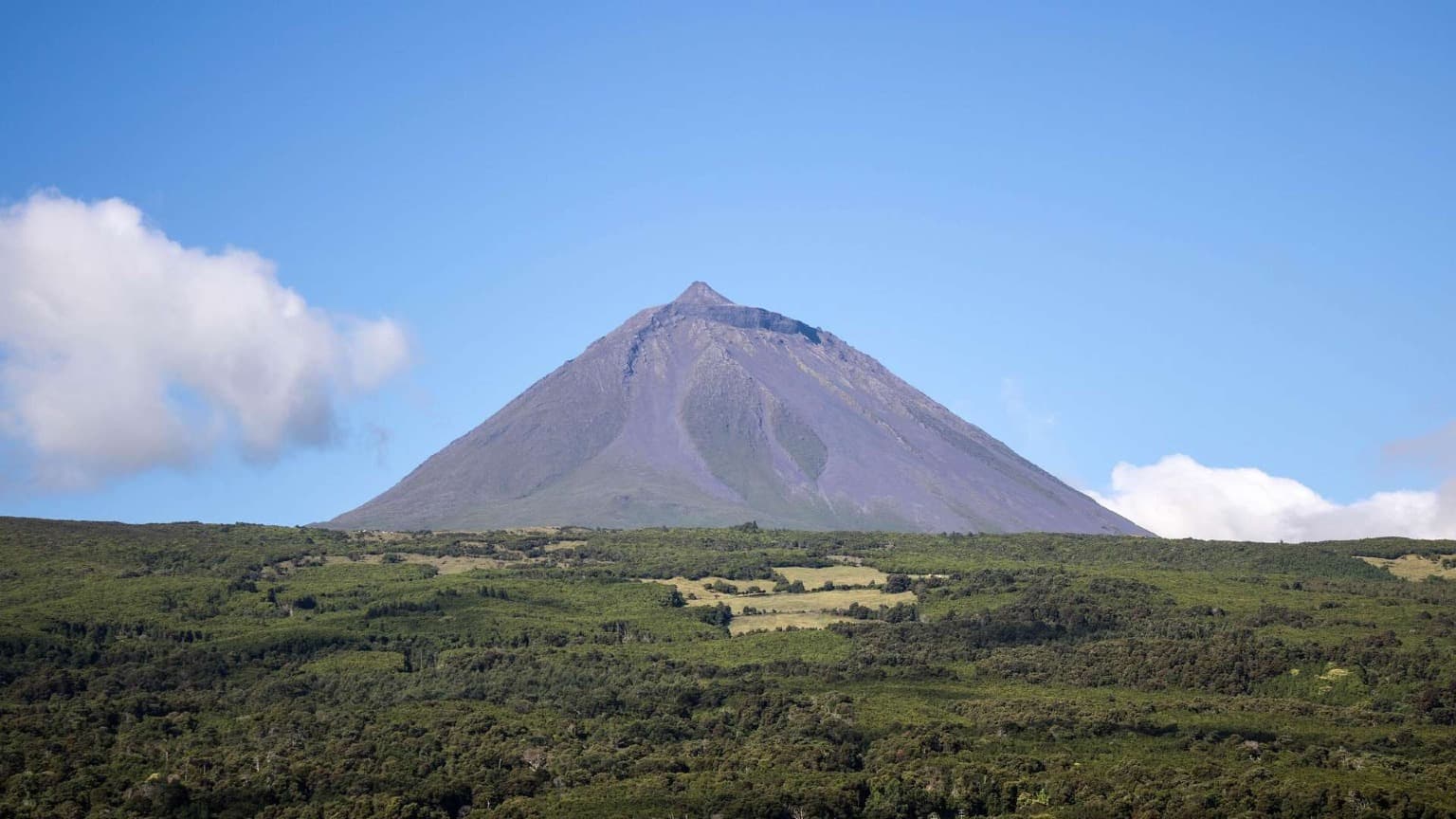
Mount Pico — Portugal’s highest peak and the defining landmark of Pico Island.
Corvo – Portugal’s Smallest Island
The tiniest of the Azores, Corvo is a peaceful, intimate island dominated by a massive volcanic crater. Its small size and welcoming community make it ideal for travelers seeking serenity.
• Caldeirão – A massive volcanic crater with two small lakes and lush green pastures, creating a surreal, otherworldly landscape.
• Vila do Corvo – Portugal’s smallest settlement, where cobblestone streets, traditional stone houses, and friendly locals offer a glimpse of authentic Azorean life.
• Ponta do Marco – A dramatic cliffside viewpoint overlooking the Atlantic, perfect for photography and spotting seabirds.
• Igreja de Nossa Senhora dos Milagres – The island’s charming church, central to local traditions and festivals.
💡 Traveler Tip: Corvo is ideal for visitors who want to disconnect completely and experience the quiet charm of the Azores’ most remote island.
Flores – Waterfalls, Cliffs & Pure Nature
At the western edge of Europe, Flores is a UNESCO Biosphere Reserve known for its dramatic landscapes, pristine nature, and incredible biodiversity.
• Poço da Ribeira do Ferreiro – A fairytale valley with dozens of waterfalls cascading down lush green cliffs — one of the most magical places in the Azores.
• Lagoas das Sete Lagoas – Seven crater lakes scattered across the island’s highlands, each with its own color and character.
• Rocha dos Bordões – Towering basalt columns formed by ancient volcanic activity, creating a striking natural monument.
• Fajã Grande – The westernmost village in Europe, with dramatic ocean views and countless waterfalls cascading down the cliffs.
• Ponta do Albernaz – A remote coastal point offering incredible views and the chance to spot seabirds and marine life.
💡 Traveler Tip: Flores is perfect for slow travelers and nature enthusiasts seeking solitude and untouched landscapes.
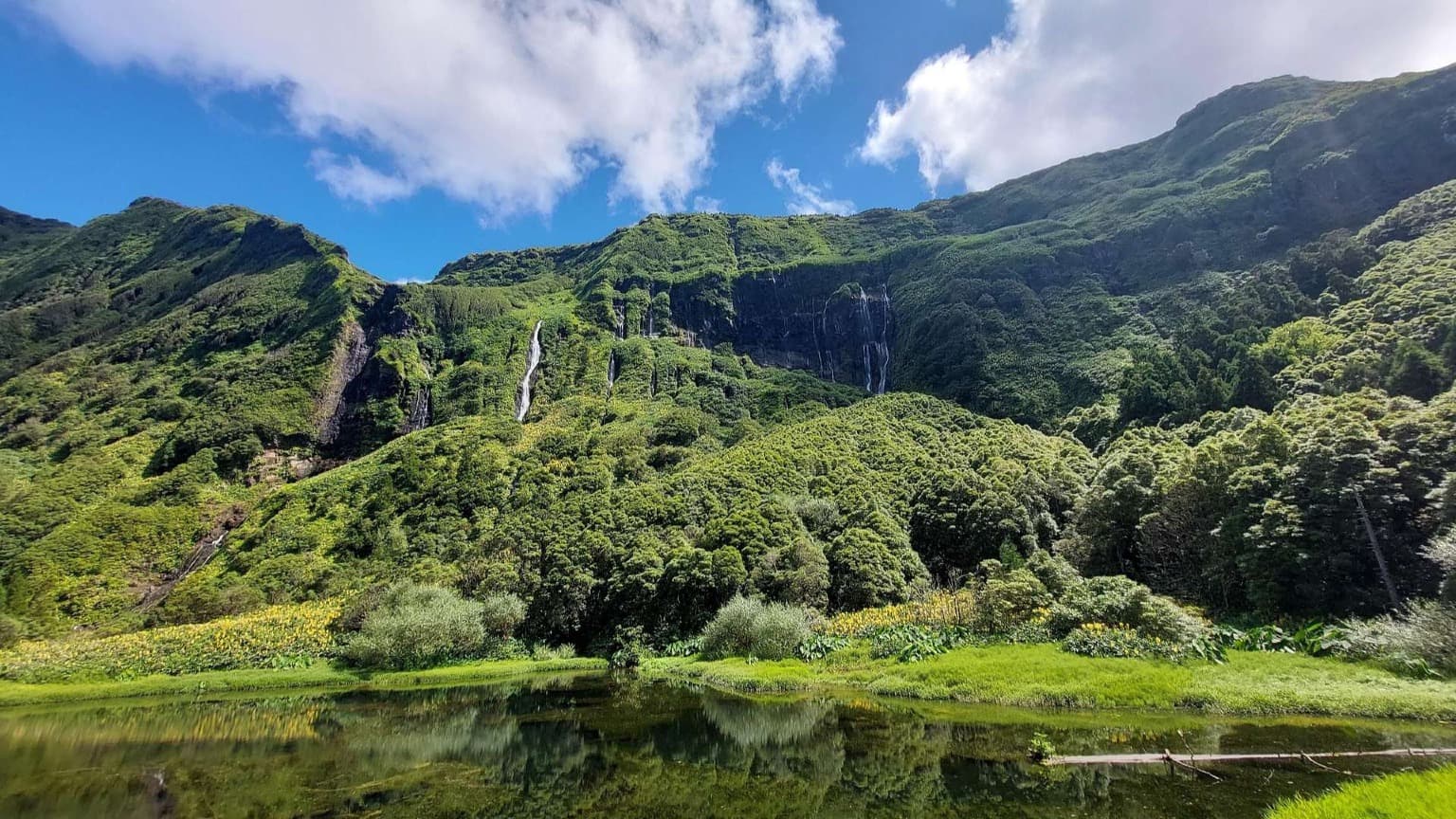
Flores Island — a UNESCO Biosphere Reserve known for its dramatic waterfalls and pristine landscapes.
Getting to & Around the Azores
Getting to the Azores
The Azores, a stunning archipelago in the North Atlantic, is accessible via several airports, with São Miguel (Ponta Delgada) and Terceira (Lajes) serving as the main international gateways. Other islands with airports include Faial (Horta), Pico, and Santa Maria, which also handle some international and regional flights. Travelers from the UK, USA, and Europe can easily reach the islands via direct flights or connecting services.
Getting Around the Azores
By Air: Inter-island travel is simple with SATA Air Açores, which connects all nine islands with frequent flights. These short flights, ranging from 20 minutes to an hour, make island hopping convenient and efficient, allowing visitors to explore multiple islands in one trip.
By Ferry: Ferries operated by Atlânticoline reliably connect the central islands of Faial, Pico, and São Jorge. While ferries are perfect for short trips and scenic crossings, flights are recommended for longer distances, such as São Miguel to Flores, especially during winter or rough seas.
By Car: Renting a car is highly recommended on most islands. Roads are generally quiet, well-maintained, and signposted, making self-driving a great way to explore hidden gems at your own pace.
By Taxi or Private Transfer: For those who prefer not to drive, taxis and private transfers are widely available. English-speaking drivers can also provide guided tours, making it easy to enjoy the islands without worrying about navigation.
By Bus: Public buses are reliable on São Miguel, covering major towns and attractions. On smaller islands, services are limited, often operating around school schedules. Renting a car or using taxis usually offers more flexibility and convenience for exploring these islands.
💡 Traveler Tip: Combining modes of transport—flying to distant islands and taking ferries between central islands—offers the most efficient and enjoyable way to experience the Azores’ natural beauty and unique culture.
Azorean Cuisine
The Azores’ volcanic soil, lush pastures, and surrounding Atlantic waters create some of Portugal’s most distinctive and flavorful dishes. The islands’ culinary traditions blend fresh seafood, locally raised meats, and artisanal products, offering a true taste of Azorean culture. Pair these dishes with a glass of Pico wine, produced from vines growing in volcanic soil, or a regional liqueur for a true Azorean culinary experience.
Best Dishes in the Azores:
• Cozido das Furnas – A hearty stew of meat, sausages, and vegetables, slow-cooked underground by natural geothermal steam in the volcanic soil of São Miguel. A must-try experience for visitors to Furnas.
• Lapas Grelhadas – Grilled limpets served with garlic, butter, and lemon. Simple yet bursting with ocean flavor, especially popular on coastal islands like São Miguel and Faial.
• Polvo à Moda dos Açores – Tender octopus simmered in red wine and herbs, highlighting the islands’ love of seafood.
• Tuna Steak from São Jorge – Freshly caught tuna, often grilled or seared, reflecting the rich fishing traditions of the central islands.
• Alcatra de Terceira – Slow-cooked beef in red wine and spices, traditionally baked in clay pots, offering a taste of Terceira’s culinary heritage.
• Queijo de São Jorge – A strong, matured cow’s milk cheese with a PDO label, perfect as a snack or paired with local bread and honey.
• Bolos Lêvedos – Sweet, soft muffins from São Miguel, often enjoyed with butter or cheese.
💡 Traveler Tip: Many Azorean restaurants focus on fresh, seasonal ingredients, so menus may change daily depending on the catch or harvest. Exploring local markets is a great way to discover even more Azorean specialties and hidden flavors.
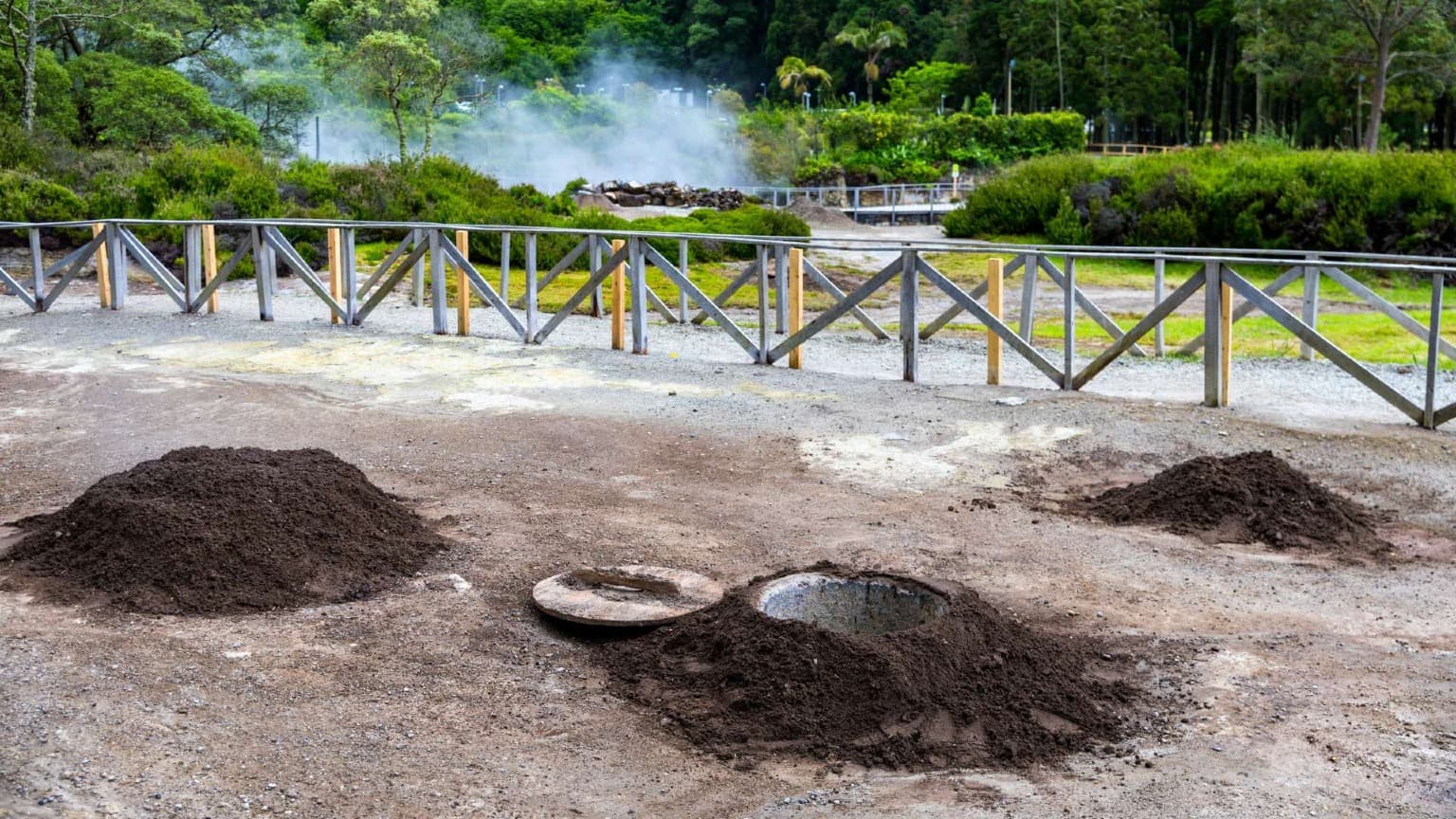
Geothermal cooking pits in Furnas, where the traditional Cozido das Furnas is slowly cooked underground.
Top 20 Restaurants in the Azores
From volcanic stews cooked underground to fine dining paired with Atlantic wines, the Azores offer one of Portugal’s most authentic and surprising culinary landscapes. Below is a curated selection of the best restaurants across São Miguel, Terceira, Pico, Faial, Flores and Santa Maria — each chosen for its quality, atmosphere and connection to local ingredients.
• Rotas da Ilha Verde (Ponta Delgada, São Miguel) – A long-time favourite since 2006, known for creative vegetarian dishes and a warm, home-style atmosphere.
• Michel Restaurant (Ponta Delgada, São Miguel) – Contemporary Portuguese cuisine in a refined setting; often considered the island’s most elegant dining experience.
• Bom Pesqueiro (Ponta Delgada, São Miguel) – Located in the port, this is one of the best fish restaurants in the Azores, renowned for freshness and simplicity.
• Gastrónomo (Ponta Delgada, São Miguel) – A family-run restaurant serving authentic Azorean dishes with excellent service and long tradition.
• Mané Cigano (Ponta Delgada, São Miguel) – One of the best local and budget-friendly lunch spots on the island, known for traditional Azorean comfort food.
• Ponta do Garajau (Ribeira Quente, Povoação, São Miguel) – A coastal favourite serving regional specialties next to one of São Miguel’s warmest beaches.
• Bar Caloura (Água de Pau, Lagoa, São Miguel) – Famous for its seaside terrace, grilled fish and unbeatable ocean views — a must-visit in São Miguel.
• Tony’s (Furnas, São Miguel) – Iconic restaurant in Furnas, best known for the traditional Cozido das Furnas, cooked underground in volcanic soil.
• Quinta dos Sabores (Rabo de Peixe, São Miguel) – A farm-to-table experience on an organic estate, offering seasonal tasting menus in a rural setting.
• Associação Agrícola (Ribeira Grande, São Miguel) – A legendary steakhouse and arguably the best destination for meat lovers in the Azores.
• Associação Agrícola (Angra do Heroísmo, Terceira) – After great success in São Miguel, this Terceira branch opened in 2018 and quickly became a reference for top-quality steaks.
• Taberna Roberto (Angra do Heroísmo, Terceira) – A warm, welcoming tavern offering fresh fish, Azorean flavours and friendly service.
• Quinta do Martelo (São Mateus da Calheta, Terceira) – Traditional Azorean cuisine served in a historical rural setting surrounded by nature.
• Beira Mar São Mateus (São Mateus da Calheta, Terceira) – Beloved seafood restaurant in a fishing village, known for its catch-of-the-day dishes.
• O Pescador (Praia da Vitória, Terceira) – One of the oldest restaurants on the island, perfect for fish and seafood lovers seeking traditional recipes.
• Azores Wine Company (Bandeiras, Pico) – A fine dining experience paired with volcanic wines — one of the archipelago’s most memorable gastronomic highlights.
• Bioma (Lajes do Pico, Pico) – Contemporary fine dining deeply connected to local ingredients, ideal after a day of whale watching.
• Cantinho das Provas (Horta, Faial) – Modern cuisine with regional products and an excellent wine list, perfect for a relaxed dinner in Horta.
• O Mergulhador (Santa Cruz, Flores) – Casual, local dishes featuring regional ingredients — a charming stop in one of the most remote islands.
• mad (Vila do Porto, Santa Maria) – A modern restaurant offering contemporary interpretations of Azorean cuisine in Santa Maria’s main town.
The Azores for Sustainable Travelers
Few destinations in the world embrace sustainability as genuinely as the Azores. Here, environmental protection isn’t a marketing concept — it’s the foundation of daily life. Recognized as a UNESCO Global Geopark and consistently ranked among the world’s leading eco-tourism regions, the Azores have built a model where nature, culture, and community coexist in balance.
More than 40% of the entire archipelago is protected land, spanning nature reserves, marine sanctuaries, volcanic calderas and coastal ecosystems. Trails are carefully maintained, whale-watching follows strict ethical guidelines, and many islands operate with high percentages of renewable energy. From local farming cooperatives to conservation-led marine tours, the commitment is visible everywhere.
Whether you’re hiking a crater rim, bathing in geothermal waters, visiting Pico’s UNESCO vineyards or staying in an eco-conscious lodge, every experience in the Azores directly supports conservation, biodiversity and local communities. It’s a destination where traveling responsibly feels natural — because the islands themselves are built on respect for nature.
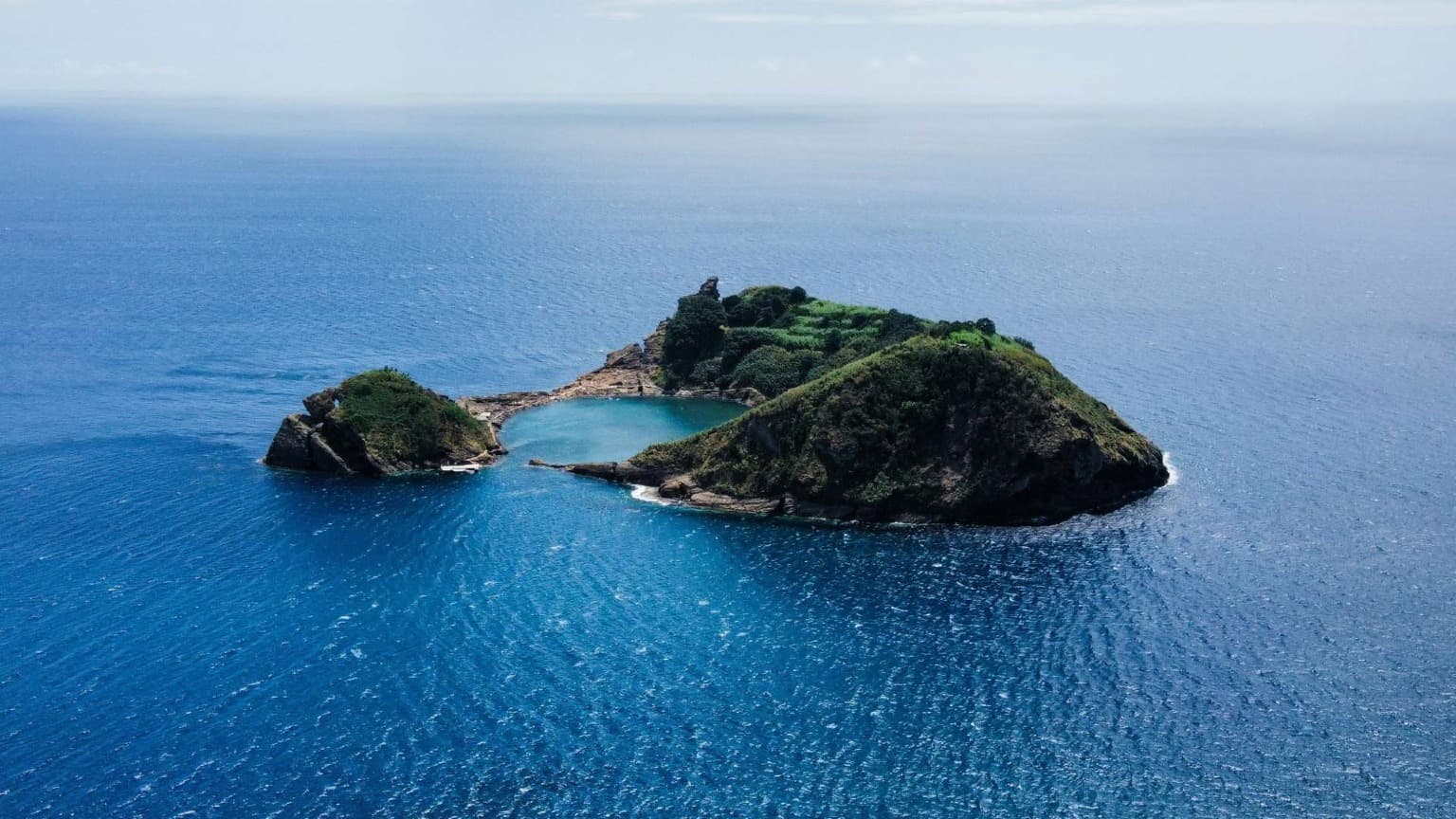
Ilhéu de Vila Franca do Campo, a natural swimming haven just off the coast of São Miguel.
FAQ: Visiting the Azores
Q: What is the best time to visit the Azores?
A: The Azores are a year-round destination, but the best months are May to October, when the weather is warmer and the sea is calmer. Winter is mild but wetter, ideal for hot springs, hiking, and quieter nature experiences.
Q: How many days do I need in the Azores?
A: For a single island such as São Miguel, plan 4–5 days. For island-hopping (São Miguel + Terceira + Pico/Faial), 7–10 days is ideal. To explore several islands deeply, consider a 10–14 day itinerary.
Q: How long does it take to get between islands?
A: Flights between the central islands (Faial, Pico, São Jorge) take 8–12 minutes. São Miguel to Terceira is 35–40 minutes. São Miguel to Flores is 1h30. Ferries between Faial and Pico take 25 minutes.
Q: Do I need a car in the Azores?
A: Yes — on most islands, renting a car is the best way to access viewpoints, hiking trails, hot springs, and small villages. São Miguel and Terceira have some bus services, but they don’t cover all main attractions.
Q: Which island should I visit first?
A: São Miguel is the easiest and most complete introduction — with crater lakes, thermal springs, and whale watching. For hiking, choose São Jorge or Flores. For wine and volcanoes, Pico is ideal.
Q: Can I see the famous crater lakes without hiking?
A: Yes. Many of the top viewpoints — Sete Cidades, Lagoa do Fogo, Furnas — are accessible by car. Trails enhance the experience, but they’re not mandatory.
Q: Is the Azores good for families?
A: Absolutely. Children love the hot springs, easy hikes, whale watching, natural pools, and safe beaches like Praia Formosa in Santa Maria or Porto Pim in Faial.
Q: Are the islands safe?
A: The Azores are one of the safest destinations in Europe, with friendly communities, low crime, and pristine natural environments. Trails are well-marked and marine activities follow strict safety guidelines.
Q: Can I visit several islands in one trip?
A: Yes. Inter-island flights and ferries make it easy. The most common combinations are:
• São Miguel + Terceira
• Faial + Pico + São Jorge (central triad)
• Flores + Corvo (western duo)
Q: What should I pack?
A: Layers. Weather can change quickly due to microclimates. Bring waterproof clothing, hiking shoes, swimwear, sunscreen, and a light jacket even in summer.
Q: Do I need to worry about volcanic activity?
A: No — the Azores are closely monitored by scientific authorities. Trails and sites remain open only when completely safe.
Plan Your Azores Experience
The Azores are one of the most extraordinary destinations in the Atlantic — nine islands of crater lakes, waterfalls, volcanic peaks, hot springs, UNESCO vineyards, and some of Europe’s best hiking. Whether you’re exploring São Miguel’s green valleys, climbing Pico, swimming in Faial’s natural pools, or chasing waterfalls in Flores, every island reveals a different side of nature.
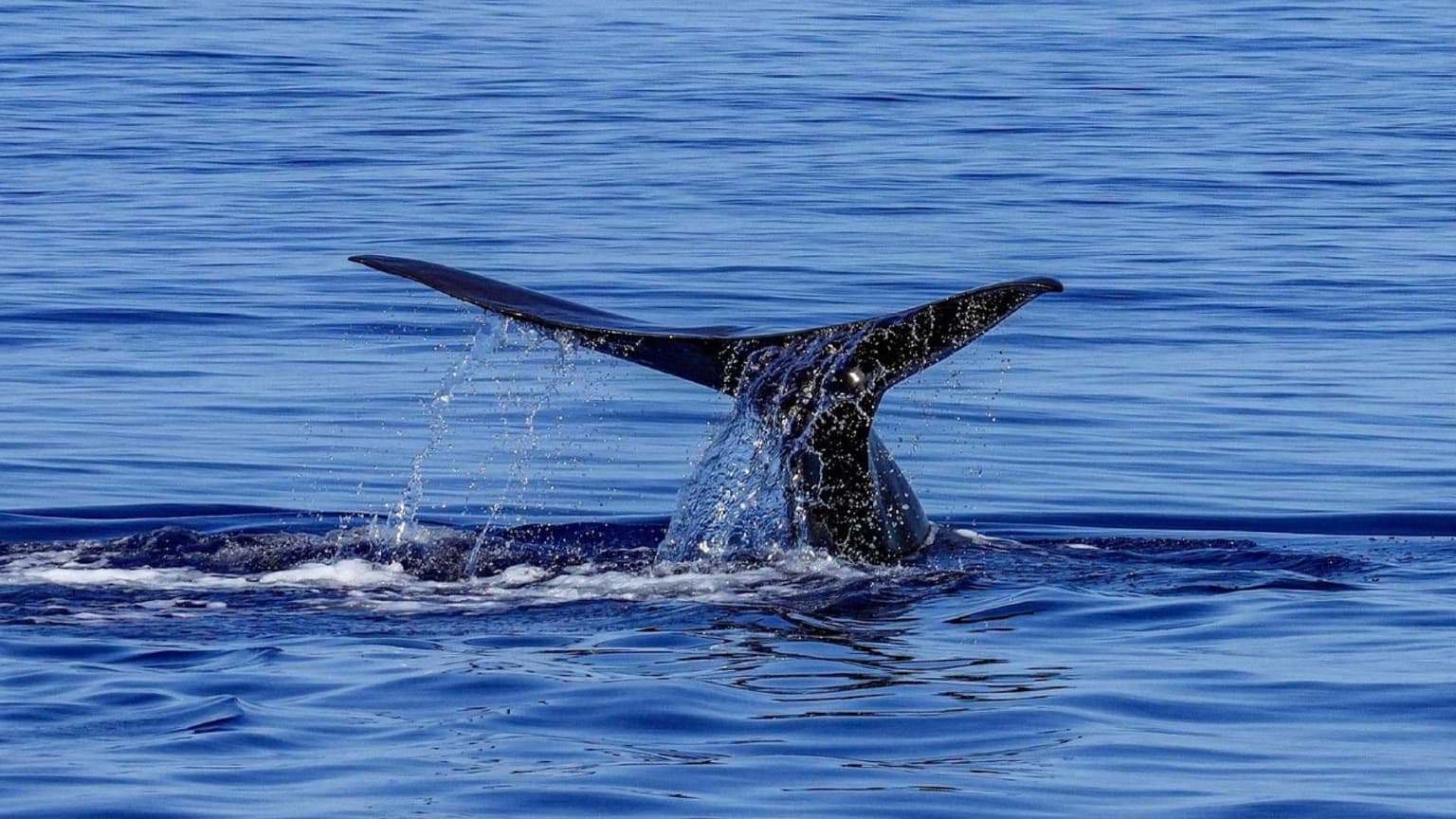
Whale watching in São Miguel — one of the best places in the Atlantic to spot sperm whales.
➡️ Cooltour Oporto will soon introduce a curated selection of tours and activities in the Azores, created in partnership with trusted local operators who share our values of authenticity and sustainability.
Our upcoming experiences will include:
• Small-group and private São Miguel highlights tours
• Ethical whale and dolphin watching with marine biologists
• Pico volcano climbs and vineyard tastings
• Terceira cultural & volcanic heritage tours
• Hiking circuits in São Jorge and Flores
• Authentic Azorean food & farm experiences
Each experience will be handpicked for quality, environmental responsibility, and connection to Azorean culture.
👉 Until then, explore our travel guides for Portugal’s most iconic regions — from the Douro Valley and Porto to Lisbon, the Algarve, Setúbal, and Central Portugal — and start planning your next adventure.